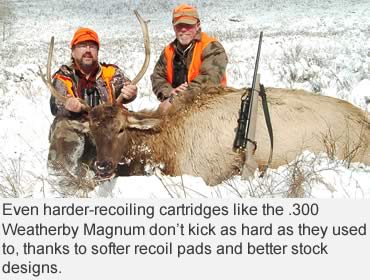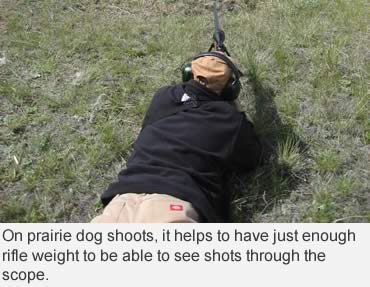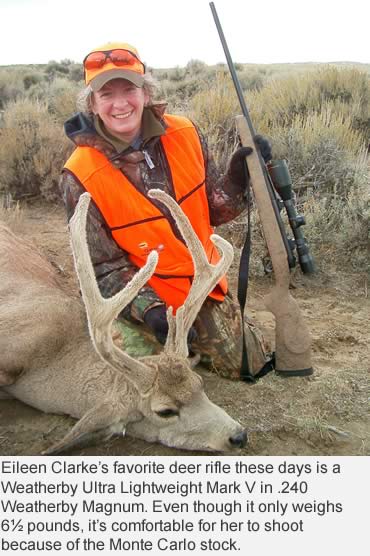Got a gun that kicks too hard or just doesn’t feel right? Here are the common problems ... and solutions.
Most hunters have a notion of how much a rifle should weigh, but think that balance and stock fit only apply to shotguns. The truth is that all three can be important, and they’re often tied to the ammunition we shoot.
Many hunters today look for the lightest possible rifle. In some hunting, though, extra weight can be very desirable — particularly when taking the smallest and largest game.
In long-range varmint shooting, a heavy rifle not only works better because it can be held steadier, but also because of lighter recoil.
The biggest benefit of reduced recoil is being able to spot your own shots through the scope. When I took up prairie dog shooting in the 1970s, cartridges like the .22-250 Remington and .243 Winchester were popular. The .22-250 was used because the bullets of the day weren’t particularly sleek, so they had to be pushed fast to remain effective at 300 yards or more. Those who shot .243s typically used their deer rifle to practice for the big game season.
Either round recoils enough that we can’t see the bullet strike. This means that for truly effective shooting, somebody else must stand beside us, spotting where the bullet lands. This isn’t as much fun as watching the bullet hit and, as with any volunteer labor, spotters vary in skill.
Many of us also found that shooting several hundred .22-250 rounds a day could eventually result in a flinch. This may seem weird, but it’s true.
Years ago, I was among several writers invited to field-test a new Kimber .22-250. It was a neat rifle, with a free-floated, fluted barrel and a nice walnut stock. With a typical varmint scope, it weighed around 9 pounds —not exactly light, but not heavy, either.
 The prairie dogs were numerous, so the shooting was fast. I kept track of how often I fired by putting the empties in a cardboard box.
The prairie dogs were numerous, so the shooting was fast. I kept track of how often I fired by putting the empties in a cardboard box.
Sometime during the middle of the second day, the .22-250 suddenly started feeling like a .375 H&H every time it went off. This was so startling that it took a few shots to recognize that I was starting to flinch unless I concentrated hard during the trigger squeeze. Suddenly (after 600-plus rounds), shooting wasn’t fun anymore. I switched to a .22 rimfire, and shooting became fun again.
This effect is even worse with a sporter-weight rifle chambered for a so-called dual-purpose varmint/deer cartridge like the .243. The .243 is a fine coyote rifle, and even pretty good for shooting ’chucks, whether Western rockchucks or Eastern woodchucks. But even a heavy-barreled .243 is a moderately miserable tool for serious prairie dog shooting.
A light deer rifle is sincerely miserable for that purpose, and it’s the main reason we don’t hear nearly as much about dual-purpose rifles anymore.
Today’s plastic-tipped varmint bullets are much more efficient than the soft points and hollowpoints of 30 years ago. I clearly remember using Nosler Ballistic Tips for this first time on a prairie dog shoot. Like many prairie dog shooters in those days, I brought both a light rifle, a .223 Remington, for close shooting and a .220 Swift for shots beyond 300 yards. After a day of shooting, I realized that with new ammo, the .223 had become a much longer-range rifle, so I didn’t shoot the .220 Swift nearly as much as planned.
After the advent of multipoint reticles, I quit shooting my .22-250s and .220 Swifts at prairie dogs entirely. The .223 is now effective at 300-500 yards, ranges formerly considered the domain of bigger rounds.
In fact, today the .223 has become my “big” prairie dog round, along with the .204 Ruger. At closer ranges, I mostly use the .17 HMR and .22 Hornet, both with plastic-tipped bullets. None of my prairie dog rifles weigh more than 9 pounds or so, yet the bullet strike can be seen through the scope in all of them. Truly heavy prairie dog rifles aren’t needed anymore, due to advances in bullets and reticles.
At the opposite end of the spectrum is big game weighing more than 1,000 pounds. For them, we tend to choose cartridges from the various .300 magnums on up to real elephant rounds. Various recoil-reducing devices such as muzzle brakes and today’s marvelous recoil pads made of assorted elastomers can help, especially if you don’t mind muzzle brakes blasting your ears or raising dust clouds. But the big recoil reducer is still rifle weight. I don’t mind one of the smaller .300 magnums such as the .300 WSM or .300 H&H in a rifle weighing 8 pounds with scope, but most of us shoot .338s, .375s and (heaven forbid) .416s or .458s in somewhat heavier rifles.
 With the African cartridges, a 9-pound rifle isn’t bad. It’s reasonably portable, yet heavy enough to take the sting out of, say, a .416 Rigby. Thankfully, we don’t shoot those rifles very often, and most African dangerous-game hunting doesn’t involve hiking up and down steep mountains. The real troublemakers, in my opinion, are the rifles between .300 and .375, mostly .338s mixed with a few .35s and 9.3s.
With the African cartridges, a 9-pound rifle isn’t bad. It’s reasonably portable, yet heavy enough to take the sting out of, say, a .416 Rigby. Thankfully, we don’t shoot those rifles very often, and most African dangerous-game hunting doesn’t involve hiking up and down steep mountains. The real troublemakers, in my opinion, are the rifles between .300 and .375, mostly .338s mixed with a few .35s and 9.3s.
I’m a fan of the .338 Winchester Magnum and have used one for quite a bit of hunting since the mid-1980s. Mine’s a custom rifle based on the FN Mauser action and originally weighed around 9 pounds scoped, because many experts claimed that’s what a .338 should weigh. I found it a pain in the, uh, arms to carry ready in my hands through lodgepole timber, and didn’t find recoil all that bad. Eventually, the rifle was fitted with a slimmer barrel and a lighter stock, losing a pound.
Back then, I was in my mid-30s and more flexible, and recoil didn’t seem as unpleasant. I also believed the experts who said 250-grain bullets were necessary for elk, moose and larger African plains game.
The .338 was developed around 250-grain bullets because when it was introduced more than 50 years ago, there weren’t very many good bullets around. A 250 at moderate muzzle velocity penetrated deeper than lighter bullets.
We have a lot of good bullets today, so I mostly use bullets in the 200-grain class. They kill quicker, shoot flatter and kick less.
You’ll often hear macho men claim that the .375 H&H isn’t really enough for dangerous game, whether brown bears or Cape buffalo. This is bull. The only reason the .375 got an iffy reputation decades ago was iffy bullets. The same bullet revolution that allows us to use smaller varmint cartridges and lighter elk bullets also boosted the .375.
If you cannot cleanly kill a brown bear or Cape buffalo with a .375 H&H, the reason isn’t the cartridge but your shooting. Virtually all of the professional hunters I’ve come to know in Africa think the .375 is the perfect buffalo cartridge for a visiting hunter. And Alaskan guides snort at the notion that it’s not adequate for brown bear. So, no, you don’t have to carry a 10-pound .416 or .458, whether wearing hip boots in Alaska or during 100-degree weather in Africa.
 Balance affects shootability as well. In the past, many lightweight rifles sported super-thin barrels, making them difficult to aim. Luckily, hunters of mountain game have finally realized this, and today we have a number of rifles made on lightweight actions with normal-weight barrels instead of the other way around.
Balance affects shootability as well. In the past, many lightweight rifles sported super-thin barrels, making them difficult to aim. Luckily, hunters of mountain game have finally realized this, and today we have a number of rifles made on lightweight actions with normal-weight barrels instead of the other way around.
This trend was started by Melvin Forbes with his New Ultra Light Arms rifles, using slim but very strong bolt actions. The lightest NULA action, the short model for rounds like the .284 Winchester, weighs 20 ounces versus the 35 ounces of a short Remington 700 action, a savings of almost a pound. This means a normal barrel can be used, yet the entire rifle will weigh 6 pounds or less with scope and still be very shootable. Since the NULA came out in the 80s, a bunch of lighter factory actions have appeared, such as the Kimber 84 and Remington 700 Titanium, bringing the advantage of a normal barrel and better balance to factory-made lightweights.
Balance can even affect heavy varmint rifles. When I still used a .22-250 for prairie dog shooting, the thought occurred to me to stuff the hollow butt of the synthetic stock on my Savage with lead shot, bringing the rifle’s weight up to 15 pounds. This would tame recoil, allowing me to spot my own shots and tolerate shooting hundreds of rounds. It didn’t work. The extra rearward weight made the rifle a pain to maneuver and less steady to shoot. Halfway through the first day, I poured the shot out.
The sensation of recoil is not only affected by rifle weight, but also by stock shape. Elastomer recoil pads help, but stock shape really begins to affect felt recoil in lighter rifles.
The common wisdom for years was that a straight buttstock reduces felt recoil because it kicks straight back instead of tilting upward into the cheekbone. This is exactly the sort of stock Melvin Forbes designed for NULA rifles.
It works very well for some people — me, for instance. However, that’s because I’m a fairly typical man: a little under average height with a relatively short neck and square shoulders. When I shoulder a straight stock, the recoil pad fits firmly against my shoulder and my cheek is firmly on the comb. This feels natural and easy.
My wife, Eileen, is a little shorter, and has a longer neck and more sloping shoulders, common among women and even found on some men. When she shoulders a straight classic stock, she has to lean her head way forward to make cheek contact with the comb. Even then, the natural position of the recoil pad is with the bottom (toe) of the pad right in the middle of her shoulder joint. Consequently the muzzle rises during recoil, and the toe of the stock pokes her in the shoulder. This doesn’t feel good.
A stock that truly fits her has the Monte Carlo hump many sophisticated rifleman think is in poor taste. It wasn’t designed to look funny, but to provide a comfortable fit for shooters with longer necks and sloping shoulders. This just happens to describe Roy Weatherby, one of the promoters of the Monte Carlo stock, though in many photos this isn’t obvious because he wore suits with padded shoulders.
Women aren’t wimps. They generally have higher pain thresholds than men, but most riflestocks don’t fit them. A couple of years ago, Eileen had a custom-fit .308 Winchester made on a Kimber action. It fits her perfectly, and she feels relatively little recoil when shooting. On the few occasions I’ve shot the .308, the little rifle has felt miserable because it doesn’t fit me. Eileen mostly uses the .308 on bigger game like elk and the larger African plains game. Her main deer rifle is a Weatherby Ultra Lightweight in .240 Wby Magnum, also with a Monte Carlo stock.
So yes, balance and fit affect how we shoot rifles. If your rifle doesn’t feel right or, worse, kicks like the devil when it shouldn’t, look beyond weight and at the stock itself.
Read More Articles by John Barsness:
• Troubles with Choke Tubes: All sorts of things prevent shotgun chokes from doing what we expect of them.
• The .30-06 Just Plain Works: Many of us know intellectually that the .30-06 is a good all-around big game cartridge, but explanations are not experience.
This article was published in the December 2009 edition of Buckmasters GunHunter Magazine. Subscribe today to have GunHunter delivered to your home.